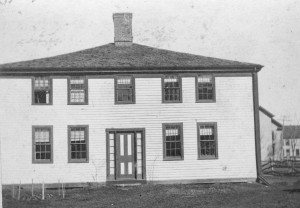True Tales from Canton’s Past: Vose Tavern
By George T. ComeauPassing a sign that reads “On this site…” usually means that the buildings or events associated with the property are long gone and history lessons can now only be found in books or a place marker. There are plenty of examples of this throughout Canton. Great examples include the site of Roger Sherman’s boyhood home, the site of the Doty Tavern, or even the site of the Crane School. Buildings, people and memories pass, and with them our history dissolves with time.

One of Canton’s most historic buildings, the Vose-Mawdsley Tavern on Washington Street at Draper Lane, circa 1880s (Courtesy of the Canton Historical Society)
Driving north on Washington Street, just past Chapman Street, look to your left as you pass Draper Lane, once called Vose Lane. Two gracious old trees stand at attention, their canopies spreading skyward with little indication today of what they once shaded. This is the site of the Vose Tavern, more accurately described as the Vose-Mawdsley Tavern.
As far as “sites” go, this one is pretty impressive and has almost 300 years of local historical associations to boast. John Vose was the first landowner of this plot. Born in 1676, he was the sixth of 12 children born to Edward Vose and Abigail Sharp of Milton.
The Vose family was landed gentry and seems to have come from means. John’s grandfather, Robert Vose, was born about 1599 in Garston, Lancashire, England. At some point Robert Vose crossed the Atlantic and came to Dorchester, first appearing in New England records when, in 1654, as a gentleman of Dorchester, he purchased a 500-acre farm in Milton at a cost of £380. John’s father, Edward, was one of 16 men who purchased Block Island in 1661 as part of a company dedicated to settling the island with rugged individualism. Edward returned to Milton, married Abigail Sharp and produced a large family. In short, the Vose family was enterprising, industrious and wealthy by colonial standards.
It was from the family that John Vose set out to make his mark. In 1697, he was appointed to supervise the common swamp and uplands outside the Ponkapoag Indian Plantation and “see that neither shingles or timber were carried away.” It is implied that by this appointment he was living in the area and that he was well regarded. In 1700, Vose married Sarah Clapp and was settled. We also know that in 1714, James Blake, the noted surveyor of Dorchester, makes a note in a survey from Moose Hill in Sharon that states “Punkepog via Voses, N. E. 56° and little.”
In 1725, Captain John Vose purchased 90 acres of land from the Ponkapoag Indians. Prior to this time, the practice was to lease the land in exchange for token goods and services. On March 22, 1725, Amos Ahauton, Thomas Ahauton, Simon George, Hezekiah Squamoag and George Hunter, all residents of the Ponkapoag Indian plantation within the township of Dorchester, conveyed their land to John Vose. The property was then located on both sides of the road and “bound north and west by country road, southwest by land of Joseph Tucker and southeast by Pequit Brook.” For the time, this was a sizeable purchase and this was where he had his tavern. By all accounts, running a tavern was hard work and led to a “liberal” atmosphere. Vose was twice accused and fined for “selling strong drink without a license.” Most notably, he was also accused of “allowing of gameing,” which was a scandalous accusation and was vigorously refuted. Vose was acquitted of this charge, but perhaps with a slap on the wrist by the hand of the judge, he was forced to pay the costs of the court.
This was a raucous establishment. The best story concerns a drunken party of young men who began drinking on a Sunday morning and continued late into the night. At some point the noise became so pronounced that William Wheeler, the “tithing-man,” was sent to enforce the laws of the Sabbath. Upon entering the taproom he was greeted with derision and laughter, and was surprised to find himself quickly overtaken and bound by his noisy tormentors, a glass of rum poured down his throat. Wheeler objected less to the second glass being forced upon him, and by the third he was as loud as his captors. Huntoon writes, “The consequence was that the preserver of the peace soon made more noise than all the rest and was to be carried home and put to bed by some of the more sober company.”
In 1734, Vose died and was buried in the Canton Corner Cemetery. The face of his headstone has long since sheared away by winter’s frost, but a footstone marks his grave. Vose is buried alongside his wife, who died in 1732 “in ye 58th year of here age.” Vose’s daughter, Sarah Hewins, sold the entire estate to Ebenezer Mawdsley in 1736.
Mawdsley, a well-to-do businessman, demolished much of the original building and rebuilt the tavern in 1737 for his two sons, Nathaniel and Samuel. Mawdsley was an enterprising man who owned an iron-smelting mill near the Neponset River and a gristmill for milling corn as well as three slaves (two servants named Cuffe and Rose are listed with Mawdsley in Dorchester’s Vital Records in 1736.) A town selectman, it was Mawdsley who helped create the layout for the present-day Pleasant Street. The work of building this new tavern was done by skilled hands, the interior being one of the finest examples of Georgian finishes to be found anywhere in America.
(Click on page 2 below to continue reading)
Page 1 Page 2
Short URL: https://www.thecantoncitizen.com/?p=7365










